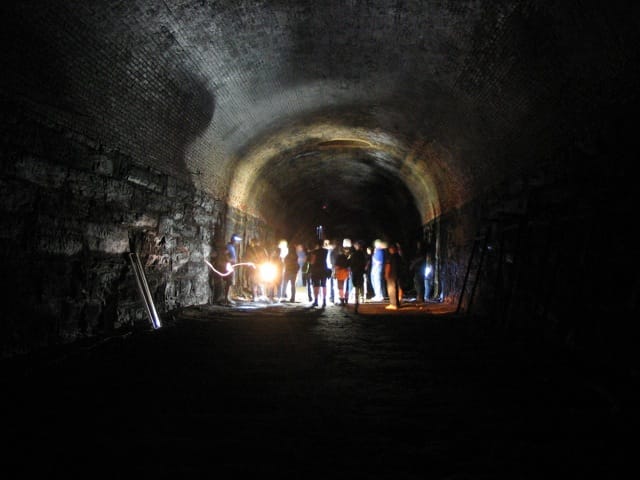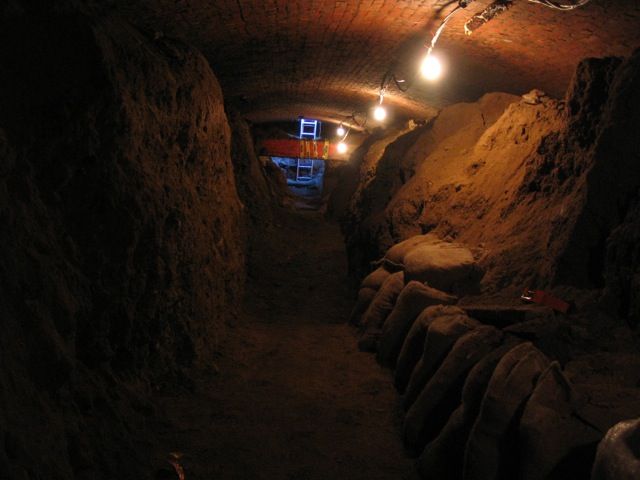The Light At The End Of The Tunnel That Never Goes Out

COBBLE HILL – Sometimes the most exciting places in New York are not found on its streets but right underneath them. Consider the Atlantic Avenue Tunnel in Brooklyn. Along with places like the 91st Street ghost station and the abandoned East 18th Street station, the tunnel is one of several abandoned underground transit spaces in New York. Built in 1844, the world’s first subway ran under Atlantic Avenue between Boerum Place and Columbia Street, according to The Brooklyn Historic Railway Association (BHRA). Constructed almost 40 years before the Brooklyn Bridge opened, it was the last step in connecting Boston with New York by rail link.

Running the trains underground satisfied investors who wanted to develop the area and residents who wanted to keep it beautiful. But benefits were offset by pollution when ventilation shafts unleashed sparks and shot plumes of smoke onto the avenue above. Residents complained, and in 1859 a New York Court prohibited coal or wood burning locomotives from entering Brooklyn, according to Robert Daley’s book The World Beneath the City. The world’s first subway had been active for only 16 years.
The tunnel lived on in the minds of New Yorkers. Rumors claimed the missing pages of John Wilkes Booth’s diary, pirates, prohibition era bootleggers, mustard gas wielding WWll spies, mobsters, and giant water rats had all found sanctuary within its walls. The tunnel became the stuff of fantasy.
This all changed in August of 1980 when a young engineering student from Flatbush, Bob Diamond, went down a manhole, crawled through a shallow chamber, broke through a brick wall and pulled the tunnel back into reality. “This blast of cold air came out from the other side, just like Raiders of the Lost Ark,” Diamond said of the moment he opened up the cavernous tunnel. The discovery was followed by eight months of obsessive researching and digging through city records. The work had paid off.

More than the tunnel, Diamond’s fascination was fixated on what he believed was inside—an abandoned 1830s engine sealed behind the far wall of the tunnel. Captivated with trains since his childhood, Diamond filled his home with model train sets in his youth and now stacks it high with piles of books on the subject. “I wanted that locomotive,” Diamond said. “As far as I’m concerned, that was mine.”
For a time it seemed he might succeed. The city reacted positively to his proposed plans for a museum in the tunnel. Private organizations offered to donate trolley cars. In 1982 Diamond started offering public tours. He formed the Brooklyn Historic Railway Association the same year. The association successfully appealed to the National Register of Historic Places which landmarked the tunnel in 1989. Diamond expanded his efforts to restoring trolley service in Dumbo and nearby Red Hook, with the goal of one day connecting the two lines.
By 2010, now flanked by a Trader Joe’s and Urban Outfitters, the neighborhood above the tunnel was different from the day Diamond first clambered down a manhole. Recent rezoning in downtown Brooklyn raised the maximum height for new developments. The dusty antique stores that once lined Atlantic Avenue were beginning to disappear and plans to open a Barney’s had recently been announced. Diamond had changed too. No longer the youthful student crawling his way into adventure, he suffered from arthritis and conducted his tours from a seat in the tunnel. His persistent nature had made him a thorn in the side of local government agencies, several of which declined to comment for this article.

Despite the neighborhood’s transformation, Diamond was shocked when his operation was shut down in 2010. Over the 30 years the tunnel was open the tours had increased in popularity. Hundreds of curious visitors were ushered weekly through the manhole in the middle of Atlantic Avenue (at Court Street). Rooftop Films held screenings in the tunnel, running series with themes like “Trapped in the Tunnel” and “Tunnel of Love.” National Geographic planned to film a documentary about the tunnel and the abandoned locomotive rumored to be sealed in its depths. The growing attention might have done more harm than good. In December of 2010, on the recommendation of the Fire Department, the DOT suspended the tours and the City of New York barred Diamond and the BHRA’s access to the tunnel.
Diamond sued the City in 2011, seeking to recover damages for fraud and breach of contract. He lost the case, the court finding that the City had the “right to revoke and terminate the consent agreement at any time.” He appealed and lost again in 2015.

Today the Atlantic Avenue entrance remains welded shut. In 2014 the owners of Chez Moi at 135 Atlantic, Tarek Debira and Patricia Ageheim, were renovating their restaurant. After a beer and some persuasion with a sledgehammer, Debira uncovered an exterior section of the tunnel behind a basement wall. Like Diamond’s comparison to Indiana Jones, Ageheim said finding the tunnel “was like opening the doors of Narnia”. The space was incorporated into a speakeasy style bar, Le Boudoir, which attracts customers with this slice of Brooklyn history. It’s a fitting fate for a tunnel once rumored to have been a hideout for bootleggers and illegal whiskey stills.
Petitions have circulated urging the City to resume the tours. Ageheim said there were reports of a residence in the area also having basement access to the tunnel. A test conducted in the tunnel shortly before it closed showed evidence there could be a large metal object behind the far wall, right where the locomotive is alleged to sit. Diamond has not given up hope he will see the inside of the Atlantic Avenue Tunnel again. Inspired by the new evidence from the test, he continues to look for new ways to regain access. Referring to a book by Chairman Mao sitting on his table, he said the process was like “long term, low intensity warfare.”
While the second life of the Atlantic Tunnel might have been a brief 30 years, this chapter closes with a new generation of Brooklynites curious about its future. Hopefully the giant rats won’t be a part of it.




